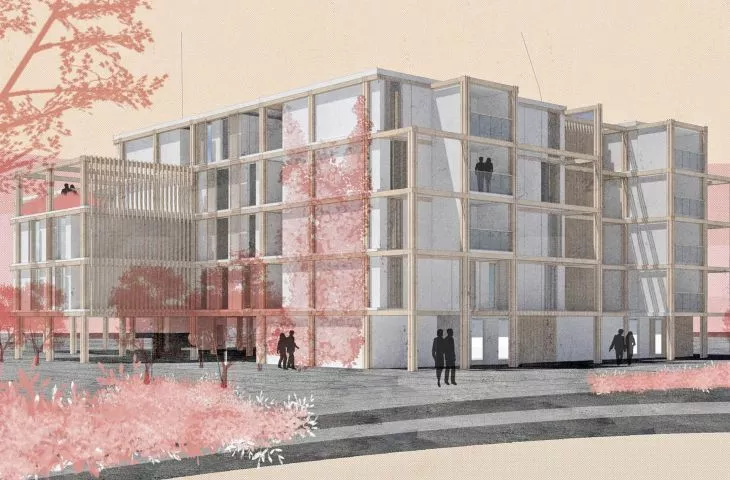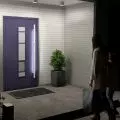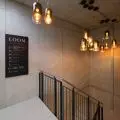In my work, I have proposed solutions that can increase the availability of housing by reducing the three most essential elements that make up the price: the cost of construction, the square footage of housing and the cost of land. Based on analyses of prefabricated systems, I developed a proprietary system that can reduce construction costs; through analyses of demographics and housing trends, I created a typology that meets the needs of residents, and through over-parking superstructure, I reduced land costs and infrastructure expenditures.
structural system
I developed a proprietary timber frame structure made of prefabricated timbers. Thanks to the elimination of load-bearing walls, it is possible to freely shape the internal structure and the facade. In addition, smaller elements are easier to transport and allow the use of less powerful machinery, which translates into reduced costs. The basic elements of the structure are prefabricated wooden columns, beams and ceilings. In order to stiffen the structure and for aesthetic reasons, the load-bearing wooden columns were separated into four smaller ones. The exterior and interior walls do not have a load-bearing function, so they can be made in light-frame technology or solid prefabricated elements installed before the final finishing layer. The elements were designed for ease of assembly and for the elements to fit tightly together through ready-made sockets, moldings and terminations that fit only in specific places.
location
The flexibility of the system allows the buildings to fit different locations. In the City of Sydney area - Sydney's inner city - the average price of a square meter of land is more than 1,050 Australian dollars (October 2017 data). It is therefore necessary to make efficient use of land through intensification of development. Cheaper land is located in the suburbs or in degraded or transportation service areas (surface parking lots). The first two categories of locations require additional infrastructure or revitalization expenditures. The last option involves using the space above the parking lot for a residential superstructure, while retaining the original function of the parking lot. Parking lots in Sydney are located in places with good transportation infrastructure, often in the vicinity of parks, sports, service or educational facilities, so the assumption is based on existing land development. According to my calculations, above the parking lots, with the maximum legally permitted height of wooden structures (eight stories), it is possible to build three to four and a half thousand apartments, with the provision of common spaces and communication. The dispersion of housing in the city prevents the formation of social housing ghettos.
Typology in the context of Sydney
Analyses of demographics and the structure of households made it possible to determine the need for the type and proportion in which housing is to be built. Sydney is mostly populated by young and middle-aged people. The largest groups are those in the 25-34 (32.9%), 35-49 (21.1%) and 18-24 (17%) age ranges. These same groups are also expected to see the highest growth over the next two decades. In addition, Sydney's population is projected to grow by more than one hundred and ten thousand over the same period, representing 14.5% of the metropolitan growth rate. The largest number is made up of one- and two-person households, where the highest growth is projected.
Because of the location, it was necessary to establish a structural grid for the facility based on the parking space module - in Australia this is 540×240 centimeters. I determined that the most economical solution would be to combine parking modules into groups of three spaces in two rows.
landscaping
The building was designed over a parking lot in the Pyrmont district, on Blackwattle Bay. A variety of commercial and public services are available within five to seven hundred meters, including grocery stores, cafes, a local market and a college. The area is well connected to the city. Within a radius of two hundred and fifty meters there are bus stops and a light rail station. For safety reasons, the organization of part of the parking lot located in the contour of the building has been changed. One of the alleys was closed and a closed parking bay was created for residents. To reduce the number of cars, carsharing was provided. The surface of the path was highlighted with color and raised. An intimate square was created on the waterfront with terraces descending towards the water, where additional plantings and a playground were proposed.
functional layout
Private spaces have been reduced in the building, making the cost of the units lower. To compensate for the small footprint, many spaces and services have been planned, such as a community kitchen, coworking spaces, a meeting room, a playground, a terrace, a communal garden, a laundry room, a storage room, a bicycle room and space for commercial services.
energy efficiency and ecology
Sydney's average annual temperature is 17.5 degrees Celsius, with the warmest month at 22.3 degrees. To improve the microclimate and reduce air-conditioning costs, cooling aids have been used. The building's open structure allows air to flow freely, bracing beams allow shade coatings to be hung, a light-colored facade, green walls and roof, and additional green plantings prevent overheating. The building features wooden sliding shutters and light breakers, and shade balconies on the west side.
Wojciech ZIENTEK
© Author













































